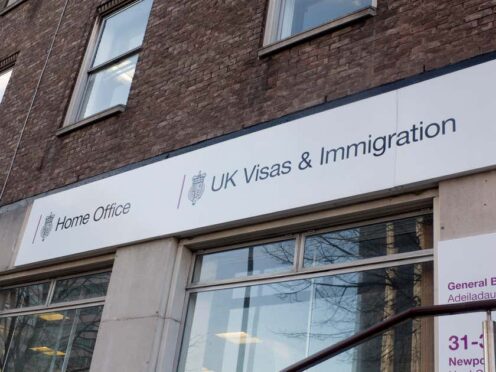
More than 128,000 people were waiting for an initial decision on their asylum application at the end of last year, figures show.
The number was down by more than a quarter on the record high reached in June last year, when more than 175,000 people were awaiting a decision.
But despite the fall, the backlog was described as “sky-high, no matter which way you slice it” by the Liberal Democrats, while the British Red Cross said thousands of people are “stuck in indefinite limbo”.

The statistics published by the Home Office on Thursday also confirm the backlog of older asylum cases – which can equate to more than one person – in the system had not been cleared by the end of 2023, despite a claim to the contrary from the Prime Minister.
The latest figures show that as of December 31, there were 3,902 legacy cases – those where applications were made before the end of June 2022 – awaiting an initial decision.
In January, the Home Office was reprimanded by the statistics watchdog after the Government was accused of lying about clearing part of the asylum backlog.
UK Statistics Authority chairman Sir Robert Chote warned the “episode may affect public trust” as he outlined the findings of the body’s investigation into complaints received about Rishi Sunak’s claim ministers had “cleared” the outstanding cases in question.
Those figures, up to December 28, showed thousands of asylum cases were waiting to be dealt with despite the Home Office saying it had succeeded in meeting Mr Sunak’s target, prompting critics to accuse the Government of playing “fast and loose” with the figures.
The latest figures also show a rise in the non-legacy backlog.
There were 91,350 applications made on or after 28 June, 2022 still awaiting an initial decision as of the end of December 2023.
That rose from 85,505 at the end of September 2023.
A total of 128,786 people were waiting for an initial decision on their asylum application at the end of December, down 20% from 160,919 at the end of December 2022.
The total is down 27% from the 175,457 people waiting for a decision at the end of June last year, which was the highest figure since current records began in 2010.
The number of people waiting more than six months for an initial decision also fell, standing at 83,254 at the end of December, down 24% year-on-year from 109,641, and also 41% down from the record 139,961 at the end of June 2023.
Liberal Democrat home affairs spokesman Alistair Carmichael said: “For all their gimmicks and grandstanding, today’s figures prove that the Conservatives have failed to deliver a credible plan to clear the asylum backlog.
“The backlog remains sky-high, no matter which way you slice it. More than 128,000 people are still waiting for an initial decision on their claim. 128,000 people who are trapped in limbo – unable to work and forced to depend on Government funds.”
The number of UK asylum applications withdrawn in 2023 was more than four times the number in 2022, a rise the Refugee Council said it was “very concerned by”.

It said: “Withdrawals should never be used as a way to reduce the backlog and should only be employed in certain, very specific circumstances.”
The organisation said withdrawals can have “terrible consequences”, with people “ending up destitute and cut off from much-needed support”.
The number withdrawn in 2023 was 24,027, relating to 25,583 people, a steep rise on 2022 when there were 5,255 withdrawn applications relating to 5,944 people.
Some 79% of withdrawn applications in 2023 were classed as “implicit withdrawals”, meaning the Home Office chose to withdraw the application rather than the applicant withdrawing it themselves.
These can cover a range of scenarios, including an applicant not attending an interview, failing to complete a questionnaire by a particular date, or not providing up-to-date contact information.
UK asylum applications refused by the Home Office also jumped sharply, with some 15,380 applications relating to 19,997 people refused in the last quarter of 2023.
This was more than three times the 4,743 applications (5,934 people) refused in July to September.
It is also the highest number of applications refused in any three-month period since July to September 2001.
The Institute for Public Policy Research think tank warned “quick decisions could come back to haunt the Home Office” with a likely “large caseload of appeals, fresh claims and returns”.
Marley Morris, IPPR associate director for migration, trade and communities, said: “At the same time, the Home Office also needs to decide how to handle the growing ‘perma-backlog’ of asylum claims which would be subject to the duty to remove under the Illegal Migration Act once it is implemented in full.
“Leaving these claims on hold indefinitely is bad for claimants stuck in limbo and bad for the Home Office, given the ongoing costs of accommodating people in hotels.”

Enjoy the convenience of having The Sunday Post delivered as a digital ePaper straight to your smartphone, tablet or computer.
Subscribe for only £5.49 a month and enjoy all the benefits of the printed paper as a digital replica.
Subscribe